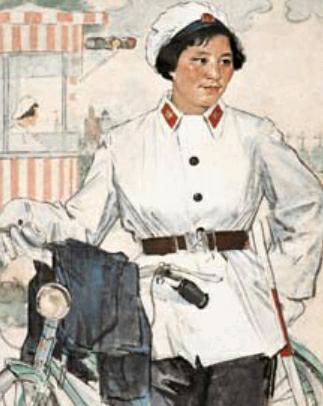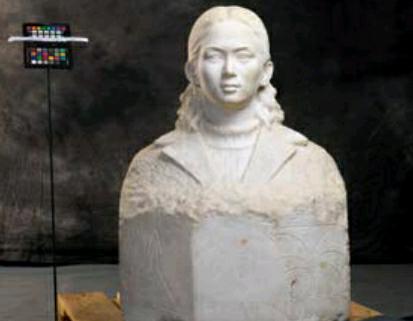An Impressive Journey
2016-10-25byYiMei
by+Yi+Mei
When the Communist Party of China (CPC) was founded, it had little more than 50 members. By the end of 2015, membership had reached 87.793 million. In 95 years, the party has grown from a peripheral minor group to a major world power. Recently, at the National Art Museum of China, celebrating this anniversary with art, “Ex- hibition for the 95th Anniversary of the Communist Party of China,” displayed the history and development of the party as well as its achievements.
The exhibition showcased over 300 works, mostly from the collection of the National Art Museum. Several generations of Chinese artists were featured, with works representing Chinese painting, print, sculpture, New Year pictures and lacquer painting. “This exhibition utilizes art to display the history and development of the CPC,” remarked Wu Weishan, curator of the museum. “Spanning a century, these works also trace the development of China under the guidance of the CPC.” The exhibition was divided into three parts.
The first part was devoted to the New Democratic Revolution period beginning in 1921, when CPC held its first national congress, through 1949, when the Peoples Republic of China was founded. In July 1921, the first national congress of the CPC was held in Shanghais French Concession. On the final day, secret agents disrupted the proceedings and the members had to move the meeting place to a boat off the coast of Jiaxing City, Hunan Province.
Oil painters He Hongzhou (1964- ) and Huang Faxiangs (1953- ) joint work Set Sail reemerged for this historical moment. Thirteen congress deputies, including Mao Zedong, Dong Biwu and Zhang Guotao, are depicted on board a vessel. On the canvas, black clouds overhead symbolize the dangerous political situation at that time. Dawn in the east integrates with the figures on the boat, hinting at the bright future ahead of the revolution and the courage of the CPC members.
Some historical events were frozen under artists brushes. Li Binghongs (1913-1986) oil painting Nanchang Uprising shows the tight, dark but promising night before the uprising. On August 1, 1927, in order to fight against the Kuomintangs large-scale massacre of communist party members, the CPC launched the Nanchang Uprising, heralding the onset of its armed resistance against Kuomintang. Against the layered purple background, the rhythm between cold and warm colors creates the feeling of vibrations in the air and the pulse of the revolution.
The second part covers the socialist revolution and construction period (1949-1987). During this era, under the guidance of the CPC, China set up the basic socialist system and established the independent and comprehensive industrial system and national system, which laid a foundation for Chinas modernization drive.
Art during this time focused on the aspiring Chinese people who discovered new hope with the founding of New China. Storm in Wilderness by Huang Zhou (1925-1997), a Chinese painting master, is one such work. The piece is inspired by the artists personal experience. When he and some colleagues trekked for a week along the Qinghai-Tibet Highway, they became exhausted but were suddenly awoken by the sound of rings on camels. They happened upon a geological team riding camels. The moment was so impressive that Huang recorded it in the work, in which the figures are bold, generous and ambitious.
At the same time, with the peaceful liberation of Tibet and Xinjiang, a series of works demonstrates ethnic minorities support for the CPC. One of Chinas most famous oil painters of the 20th Century, Dong Xiwen (1914-1973) painted Turning over the Land displaying the serfs in Tibet becoming owners of their land and happily working for their own benefit. The tipped posture of the figure and the raised hoofs of the yak as well as long strokes of earth make the painting sated with progressive ideals. Towering mountains and blue sky are set off by the peach red coat of a woman, which lightens the work and deepens its connotations.




The third part displays Chinas reform and opening up and its socialist modernization. Since starting reform and opening up in 1978, China has achieved great development, which has in turn provided considerable inspiration for artists. Themes include historic events like the construction of the Qinghai-Tibet Railway, fighting SARS and earthquake relief.
At the same time, artists began paying greater attention to Chinese ordinary workers. When he visited Taihang Mountains where a revolutionary base was once located, Sun Jian (1961- ) met a group of migrant workers dressed in fashionable clothes, which inspired the work Autumn Sun. The work documents fruits of reform and opening up, the tremendous improvements in farmersliving condition in remote areas and cheerful outlooks from so many.
“Boasting great variety, the exhibition not only illuminates the arduous and glorious road the party has walked over the past 95 years, but also displays Chinese peoples great achievements in art,” declares art critic Shao Dazhen, professor at the Central Academy of Fine Arts. “Its like a condensed version of modern Chinese art history, moving people with content, form and artistic language. I believe it will draw much attention from both the public and art circles.”
